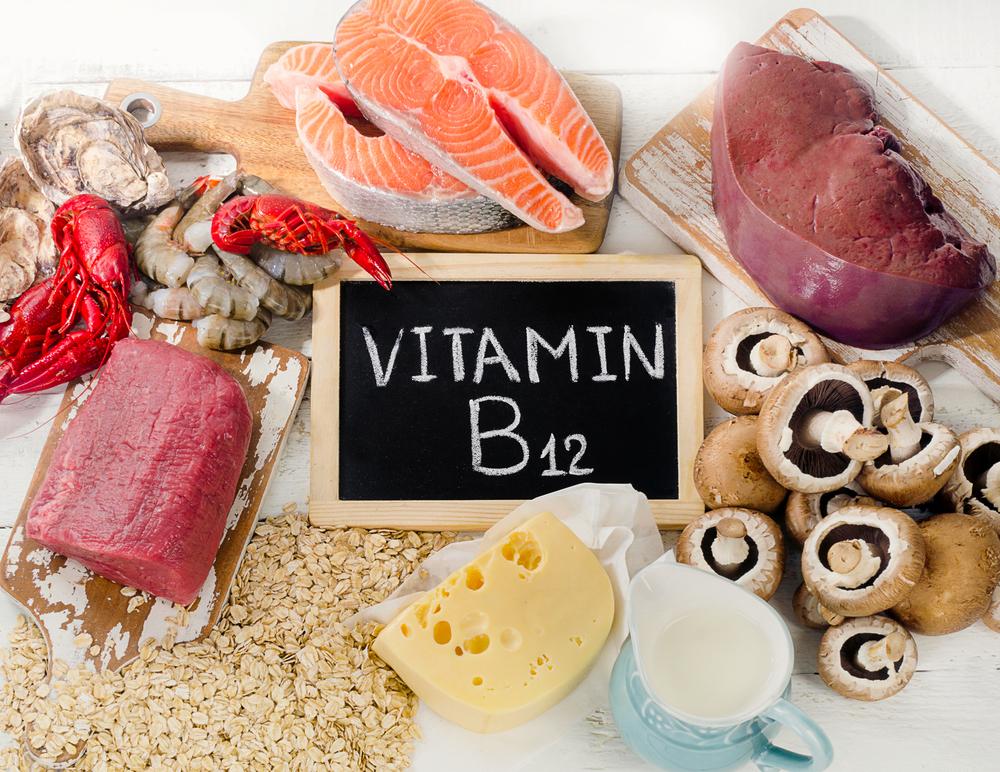-
£29.99£29.99£119.00£19.99£6.99
Cart
8
Cart
8


 Read Now
Read Now
 Read Now
Read Now
 Read Now
Read Now
 Read Now
Read Now
 Read Now
Read Now
 Read Now
Read Now
 Read Now
Read Now
 Read Now
Read Now
 Read Now
Read Now
 Read Now
Read Now
-
£29.99£29.99£119.00£19.99£6.99

Why Your Dog Needs Vitamin B12
- October 12, 2020
- 5 min read
Vitamin B12, also known as cobalamin, is a water-soluble vitamin which means no matter how much it is absorbed; any excess will be excreted via urine. It is critical for a range of functions in the body and if you have looked in any multivitamin aisles in the supermarket, it is one of the well-known B complex vitamins.
A common deficiency in human vegetarians,disorders of cobalamin metabolism are seemingly increasing in small animal medicine. The causes of deficiency range from chronic gastrointestinal disease to hereditary disease, but what is clear is the health impact of low levels.
Suboptimal B12 levels result in:
Vitamin B12 is essential for DNA and RNA synthesis and for cellular energy production.
All cells in all bodies need to know what they are doing and they need energy to do them! There are no known naturally occurring bioactive forms of B12 in plant sources. This is because B12 is synthesised by the bacteria in the gastrointestinal tract of animals, and then absorbed by the host animals. B12 is concentrated in their tissues, which is then eaten by other animals.
And, there are certain many parts of the body that need and use it.
Methionine Cycle
B12 plays a vital role in the methionine cycle, which is involved in a range of cellular functions, particularly converting homocysteine to methionine. Methionine can be converted into sulphur-containing molecules which protect tissues,modify DNA, and ensure correct functioning of cells. Methionine also plays a role in creating new proteins in the body, which is essential when older proteins degrade. Whilst it has a role in a range of functions, there have been suggestions that cancer cells too are methionine dependent. Yet, when methionine is replaced with its precursor homocysteine, cancer cell growth is inhibited.
Findings here
That said, methionine is a key player in producing glutathione. Glutathione is often referred to as the body’s master antioxidant. It is composed of the three amino acids cysteine, glycine and glutamate. Glutathione is an important part of the body’s defence systems. Free radicals are like the exhaust fumes of work, work that the body carries out on a day to day basis. An imbalance in free radicals can result in oxidative stress, something which glutathione can alleviate. Glutathione depletion is often linked with low immune function and increased infection. It has also been found to be protective of skin, lens, cornea and retina damage.
Findings here
The balance of homocysteine is important,and B12 (along with B6) has the greatest effect on those levels. High levels of homocysteine are often linked to the early development of heart disease, along with Alzheimer’s (in humans), birth defects, blood clots, endothelial damage, and stroke.
Resistance to Insulin
Findings here
Lipid (Fat) Metabolis
Low levels of B12 have been noted to increase levels of adiposity, triglycerides, and total cholesterol. It is suggested that deficiency inhibits the oxidation of fatty acids. In these cases, there is also an increase in pro inflammatory cytokines.
Findings here
The dysregulation of lipid metabolism raises another interesting element.
The nervous system has a rich lipid composition. Myelin sheaths are sleeves of fatty tissue that protect nerve cells. These nerve cells carry messages around the body. This is why low levels of B12 can lead to peripheral neuropathy. Without sufficient B12, the myelin sheath is damaged (demyelination) resulting in the disruption of nerve signals between the spinal cord and different parts of the body. This is the same mechanism that occurs in degenerative myelopathy. Whilst it is generally deemed a genetic condition in dogs (specific to certain breeds), in human studies, low levels of B12 have been associated with the condition. B12 deficiency is often a differential diagnosis to degenerative cervical myelopathy in humans too.
Findings here
Humans with low B12 often report progressive tingling in fingers and toes, without the ability to speak, it is unclear whether these symptoms affect our dogs too, but certainly poses food for thought in itchy cases.
Findings here
Anaemia
The most recognised deficiency of B12 is anaemia. B12 is involved in the formation of healthy red blood cells; anaemia is when the body doesn’t have enough of them. Pernicious anaemia is usually a result of malabsorption of B12 due to a lack of intrinsic factor, the protein found in the stomach. Without enough B12, the red blood cells don’t divide normally (thanks to errors in their DNA)resulting in abnormally large cells. There are then fewer of them and also carry less oxygen. Pernicious anaemia is associated with damage to the nervous system and digestive tract.
Pernicious anaemia (PA) is deemed an auto-immune disorder, whereby the body attacks its own cells; in this example, the intrinsic factor protein and/or the parietal cells that produce it.
It has also been associated with other auto-immune disorders like diabetes mellitus and thyroid disease. There is a high prevalence of B12 deficiency in hypothyroid patients (in humans). These patients are found to have anti-bodies against gastric parietal cells (they also have intrinsic factor antibodies). Atrophic gastritis results, which is a chronic inflammation of the gastric mucosa. It is characterised by the loss of glandular cells and replaced with connective tissue. The parietal cells also produce HCI which aids protein digestion, modulates bacterial growth, and encourages the flow of bile and pancreatic enzymes; so, this too is then impaired.
Neurotransmitters
B12 is an essential cofactor in the synthesis of neurotransmitters such as serotonin and dopamine. Low B12 is associated with mood and sleep disorders and in humans and a range of psychiatric manifestations.
Findings here
It is considered more common in ageing humans, so this poses food for thought for anxious dogs, especially if they are getting older.
Findings here
Stress
Findings here
The last mechanism by which B12 levels are affected during times of stress is due to its role in the synthesis of various hormones and neurotransmitters. B12 is involved in the production of adrenaline and noradrenalin, along with serotonin. The more they are produced,the more B12 is depleted. Many human studies have suggested that increased B12 levels demonstrate lower perceived anxiety and stress.
Findings here
What causes low B12?
As we have explored, auto immune issues can affect the metabolism of B12. This also includes conditions like Crohn’s Disease and ulcerative colitis. These are both types of inflammatory bowel disease (IBD). B12 is absorbed in the small intestine which is affected in cases of IBD. There are also cases of B12 malabsorption in exocrine pancreatic insufficiency.
Findings here
Low dietary intake can also result in depressed levels. Human vegetarians and vegans often experience low levels of B12 because there is no known bioactive form of B12 found in plants. B12 is found in meat, fish, poultry and eggs. Some commercial pet foods are fortified with B12 with cyanocobalamin being the synthetic version of choice. It is often stable in air and heat for a couple of hours but prolonged exposure to light causes irreversible decomposition and inactivation.
Findings here
There also appear to be drug interactions which affect metabolism.
Sources of B12
Lamb Liver – Raw – 90mcg per 100g
Lamb Kidney – Cooked – 79mcg per 100g
Lamb Liver – Cooked – 77mcg per 100g
Beef Liver – Cooked – 71mcg per 100g
Veal Liver – Cooked – 73mcg per 100g
Turkey Liver – Cooked – 58mcg per 100g
Salmon – 29mcg per 100g
Beef Kidneys – Raw – 27mcg per 100g
Lamb Brain – 24mcg per 100g
Mackerel – 19mcg per 100g
Chicken Liver – 17mcg per 100g
Herring – 13mcg per 100g
Whilst dietary intake will go someway to ensuring adequate levels, issues in its metabolism can also result in deficiency. For that reason, a healthy system is key to maintaining beneficial levels.
It is clear that B12 has a range of functions in the body, from maintaining the normal differentiation, proliferation and metabolic status of cells to many enzymatic reactions, including the methionine cycle. It is also an essential cofactor in the synthesis of neurotransmitters such as serotonin and dopamine, so not only could a deficiency cause obvious physical symptoms, there may be mood alterations too. Cats and dogs cannot synthesise their own B12, so they must get it from dietary sources, but it is clear, there are no known active plant forms of it. Meats sources have the highest content; but as with all nutrients, a healthy system is key to digest and metabolise it.
If you would like to know more about our services and what we can offer, check us out.
Consultations
Thanks for reading.
MPN Team x
A common deficiency in human vegetarians,disorders of cobalamin metabolism are seemingly increasing in small animal medicine. The causes of deficiency range from chronic gastrointestinal disease to hereditary disease, but what is clear is the health impact of low levels.
Suboptimal B12 levels result in:
- Blood cell count abnormalities
- Disorders of lipid and protein metabolism
- Failure to thrive
- Anorexia
- Lethargy
- Vomiting
- Mood disorders/cognitive decline
- Slow healing
- Shortness of breath
- Muscle weakness
- Unsteady movement
- Increased homocysteine levels
- Functional folate deficiency
Vitamin B12 is essential for DNA and RNA synthesis and for cellular energy production.
All cells in all bodies need to know what they are doing and they need energy to do them! There are no known naturally occurring bioactive forms of B12 in plant sources. This is because B12 is synthesised by the bacteria in the gastrointestinal tract of animals, and then absorbed by the host animals. B12 is concentrated in their tissues, which is then eaten by other animals.
Sources of B12 include red meat, fish, dairy and eggs. This is why human vegetarians and vegans are often low in it.Once ingested, dietary protein is partially digested by pepsin (digestive enzyme) and hydrochloric acid (HCI). Here Cbl (cobalamin) is released and binds to another protein called haptocorrin. Haptocorrin is then digested by pancreatic proteases (things that breakdown protein); freeing Cbl which can then bind to intrinsic factor. This then forms the B12 complex which travels through the small intestine. Here, there are receptors for intrinsic factor. The complex is internalised into the ileal enterocyte, and then released into the plasma, binding to a plasma protein. B12 is then delivered to those body parts that use and need it.
And, there are certain many parts of the body that need and use it.
Methionine Cycle
B12 plays a vital role in the methionine cycle, which is involved in a range of cellular functions, particularly converting homocysteine to methionine. Methionine can be converted into sulphur-containing molecules which protect tissues,modify DNA, and ensure correct functioning of cells. Methionine also plays a role in creating new proteins in the body, which is essential when older proteins degrade. Whilst it has a role in a range of functions, there have been suggestions that cancer cells too are methionine dependent. Yet, when methionine is replaced with its precursor homocysteine, cancer cell growth is inhibited.Findings here
That said, methionine is a key player in producing glutathione. Glutathione is often referred to as the body’s master antioxidant. It is composed of the three amino acids cysteine, glycine and glutamate. Glutathione is an important part of the body’s defence systems. Free radicals are like the exhaust fumes of work, work that the body carries out on a day to day basis. An imbalance in free radicals can result in oxidative stress, something which glutathione can alleviate. Glutathione depletion is often linked with low immune function and increased infection. It has also been found to be protective of skin, lens, cornea and retina damage.
Findings here
The balance of homocysteine is important,and B12 (along with B6) has the greatest effect on those levels. High levels of homocysteine are often linked to the early development of heart disease, along with Alzheimer’s (in humans), birth defects, blood clots, endothelial damage, and stroke.
Resistance to Insulin
Mouse studies have suggested that restricted B12 and methionine resulted in an increased resistance to insulin.Insulin is the gatekeeper for glucose getting into cells. Without insulin, glucose remains in the blood without a party to go to. It is argued that the restriction resulted in the lower availability of molecules that are vital to the process of DNA methylation (regulator of gene expression). These gene expressions were modulators underlying the development of resistance to insulin.
Findings here
Lipid (Fat) Metabolis
Low levels of B12 have been noted to increase levels of adiposity, triglycerides, and total cholesterol. It is suggested that deficiency inhibits the oxidation of fatty acids. In these cases, there is also an increase in pro inflammatory cytokines.Findings here
The dysregulation of lipid metabolism raises another interesting element.
The nervous system has a rich lipid composition. Myelin sheaths are sleeves of fatty tissue that protect nerve cells. These nerve cells carry messages around the body. This is why low levels of B12 can lead to peripheral neuropathy. Without sufficient B12, the myelin sheath is damaged (demyelination) resulting in the disruption of nerve signals between the spinal cord and different parts of the body. This is the same mechanism that occurs in degenerative myelopathy. Whilst it is generally deemed a genetic condition in dogs (specific to certain breeds), in human studies, low levels of B12 have been associated with the condition. B12 deficiency is often a differential diagnosis to degenerative cervical myelopathy in humans too.
Findings here
Humans with low B12 often report progressive tingling in fingers and toes, without the ability to speak, it is unclear whether these symptoms affect our dogs too, but certainly poses food for thought in itchy cases.
Findings here
Anaemia
The most recognised deficiency of B12 is anaemia. B12 is involved in the formation of healthy red blood cells; anaemia is when the body doesn’t have enough of them. Pernicious anaemia is usually a result of malabsorption of B12 due to a lack of intrinsic factor, the protein found in the stomach. Without enough B12, the red blood cells don’t divide normally (thanks to errors in their DNA)resulting in abnormally large cells. There are then fewer of them and also carry less oxygen. Pernicious anaemia is associated with damage to the nervous system and digestive tract.Pernicious anaemia (PA) is deemed an auto-immune disorder, whereby the body attacks its own cells; in this example, the intrinsic factor protein and/or the parietal cells that produce it.
It has also been associated with other auto-immune disorders like diabetes mellitus and thyroid disease. There is a high prevalence of B12 deficiency in hypothyroid patients (in humans). These patients are found to have anti-bodies against gastric parietal cells (they also have intrinsic factor antibodies). Atrophic gastritis results, which is a chronic inflammation of the gastric mucosa. It is characterised by the loss of glandular cells and replaced with connective tissue. The parietal cells also produce HCI which aids protein digestion, modulates bacterial growth, and encourages the flow of bile and pancreatic enzymes; so, this too is then impaired.
Neurotransmitters
B12 is an essential cofactor in the synthesis of neurotransmitters such as serotonin and dopamine. Low B12 is associated with mood and sleep disorders and in humans and a range of psychiatric manifestations.Findings here
It is considered more common in ageing humans, so this poses food for thought for anxious dogs, especially if they are getting older.
Findings here
Stress
B12 can also be depleted in times of stress.This occurs from a range of mechanisms. Stress is a physiological response; in the presence of a threat, the sympathetic nervous system kicks in for fight or flight. Energy is diverted to the brain and muscles as these are the parts of the body needed to escape. Once the threat has been resolved, the parasympathetic nervous system kicks in, returning energy too the bodily functions, which is why it is known as the rest and digest phase. In times of chronic stress, digestive functions can be significantly altered, which can result in malabsorption of nutrients, in this case B12. There are also suggestions that gastric acid can vary during times of stress, increasing or decreasing depending on the personality of the host. Changes in stomach acid secretion can also affect the digestion and absorption of nutrients.
Findings here
The last mechanism by which B12 levels are affected during times of stress is due to its role in the synthesis of various hormones and neurotransmitters. B12 is involved in the production of adrenaline and noradrenalin, along with serotonin. The more they are produced,the more B12 is depleted. Many human studies have suggested that increased B12 levels demonstrate lower perceived anxiety and stress.
Findings here
What causes low B12?
As we have explored, auto immune issues can affect the metabolism of B12. This also includes conditions like Crohn’s Disease and ulcerative colitis. These are both types of inflammatory bowel disease (IBD). B12 is absorbed in the small intestine which is affected in cases of IBD. There are also cases of B12 malabsorption in exocrine pancreatic insufficiency.Findings here
Low dietary intake can also result in depressed levels. Human vegetarians and vegans often experience low levels of B12 because there is no known bioactive form of B12 found in plants. B12 is found in meat, fish, poultry and eggs. Some commercial pet foods are fortified with B12 with cyanocobalamin being the synthetic version of choice. It is often stable in air and heat for a couple of hours but prolonged exposure to light causes irreversible decomposition and inactivation.
Findings here
There also appear to be drug interactions which affect metabolism.
Proton pump inhibitors inhibit the production of stomach acid which is needed to release B12 from food. A common medication used to treat gastroenteritis in dogs is omeprazole.Findings here
Sources of B12
Lamb Liver – Raw – 90mcg per 100gLamb Kidney – Cooked – 79mcg per 100g
Lamb Liver – Cooked – 77mcg per 100g
Beef Liver – Cooked – 71mcg per 100g
Veal Liver – Cooked – 73mcg per 100g
Turkey Liver – Cooked – 58mcg per 100g
Salmon – 29mcg per 100g
Beef Kidneys – Raw – 27mcg per 100g
Lamb Brain – 24mcg per 100g
Mackerel – 19mcg per 100g
Chicken Liver – 17mcg per 100g
Herring – 13mcg per 100g
Whilst dietary intake will go someway to ensuring adequate levels, issues in its metabolism can also result in deficiency. For that reason, a healthy system is key to maintaining beneficial levels.
It is clear that B12 has a range of functions in the body, from maintaining the normal differentiation, proliferation and metabolic status of cells to many enzymatic reactions, including the methionine cycle. It is also an essential cofactor in the synthesis of neurotransmitters such as serotonin and dopamine, so not only could a deficiency cause obvious physical symptoms, there may be mood alterations too. Cats and dogs cannot synthesise their own B12, so they must get it from dietary sources, but it is clear, there are no known active plant forms of it. Meats sources have the highest content; but as with all nutrients, a healthy system is key to digest and metabolise it.
If you would like to know more about our services and what we can offer, check us out.
Consultations
Thanks for reading.
MPN Team x
Customer Reviews
Explore related products
Related articles

Dietary NeedsHeart HealthStress
How To Strengthen My Dog’s Immune System
Dec 07 2023
•
9 mins 15 secs

Dietary NeedsHeart HealthStress
Can Stress Cause My Pet’s Disease?
Nov 23 2023
•
10 mins 30 secs

Dietary NeedsHeart HealthStress
The Lowdown on Lymphoplasmacytic Gastritis
Nov 02 2023
•
6 mins 45 secs

Dietary NeedsHeart HealthStress
Why Does My Dog Have High Folate Levels?
Oct 12 2023
•
8 mins 10 secs

Dietary NeedsHeart HealthStress
5 Benefits of Vitamin C for Your Dog
Mar 18 2023
•
4 mins 42 secs

Dietary NeedsHeart HealthStress
Does My Pet’s Skin Have Its Own HPA Axis?
Sep 12 2022
•
6 mins

Dietary NeedsHeart HealthStress
How Can We Support the Stressed Cat?
Jun 02 2022
•
6 mins 35 secs

Dietary NeedsHeart HealthStress
Using Nutrition to Support The Stressed Dog
Apr 13 2022
•
8 mins 11 secs

Dietary NeedsHeart HealthStress
5 Nutrients To Support Your Anxious Dog
Mar 28 2022
•
3 mins

Dietary NeedsHeart HealthStress
Can Stress Affect My Dog’s Digestive System?
Jul 26 2021
•
8 min read
✕

















